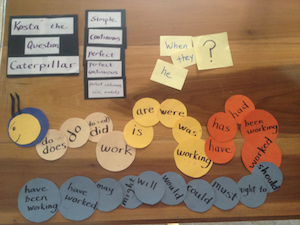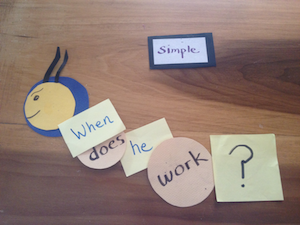Answer: When working with learners, we may want to provide them with an array of multi-sensory activities. This activity is great for hands-on learners because it requires the learners to handle the paper circles to form the caterpillar's body and 'reshape' its body parts to revise question formation! The only minor preparation by the teacher is to cut out the 'manipulatives' for this grammar game, which is designed to help learners practice and consolidate the formation of the interrogative forms of verb tenses that have been presented to them.
TITLE: "The Question Caterpillar"
LEVEL: A2+, age 9+
SKILLS: Speaking & Writing, Tense Grammar consolidation/revision
MATERIALS: Before class, you will need up to 5 colors of construction paper from which you will cut out circles to form the body of your class Question Caterpillar. The number of colors will be determined by how many of the verb tenses you wish to practise/revise with your learners.
Here are examples of a number of tenses and how many/ which circles need to be prepared. The main verb in these examples is 'work'; for the activity, you can use a number of verbs as you see fit.
1. PRESENT CONTINUOUS - 3 yellow circles: is, are, present participle form - 'working'.
2. PAST CONTINUOUS - 3 yellow circles: was, were, 'working'.
3. SIMPLE PRESENT & PAST 4 beige circles: do, does, did, 'work'
4. PRESENT & PAST PERFECT & PERFECT CONTINUOUS 5 orange circles: has, have, had, 'worked', 'been working'
5. PERFECT CONTINUOUS WITH MODALS 10 blue circles: will, would, could, may, might, should, must, ought to, have worked, have been working
Additional cards: Other than the verb cards of your choice, you can make white circles/rectangles with question words: How long, What, When, Where.. and proper names or subject pronouns: she, he, they... Also, punctuation cards: comma, full stop and question mark should be made and, for Yes/No questions, capitalized auxiliary verb circles (e.g. Do, Are, Have...).
IN CLASS:
1. Place The Question Caterpillar's body parts for learners to choose from so that they can form the interrogative of the verb tense you would like them to practise.

2. Introduce The Question Caterpillar by telling the learners that his job is to make questions BUT, being very lazy, The Question Caterpillar likes others to do his work for him! (In the following example with the simple present, we would use the beige circles.)
3. Call on a pair of learners to form a simple present question. Encourage the learners to select from the beige circles, move them and place them on their desk or stick (blu-tak) them on the board in the correct order.

They can write any missing words of the question or choose from the rectangle Question-word or pronoun cards to complete their question. (See photo below.)
Ask them to speak the question once they form it correctly.
RATIONALE
Constructing correct negative and interrogative forms in English can confuse learners whose mother tongue doesn't make use of auxiliary verbs and/or changes in word order. Hence, additional practice and revision are advisable. The Question Caterpillar affords kinesthetic practice for those learners who enjoy it, while those who may not are provided with a multi-sensory variation to help them consolidate patterns.
Suzanne and Lilika
November 2018

